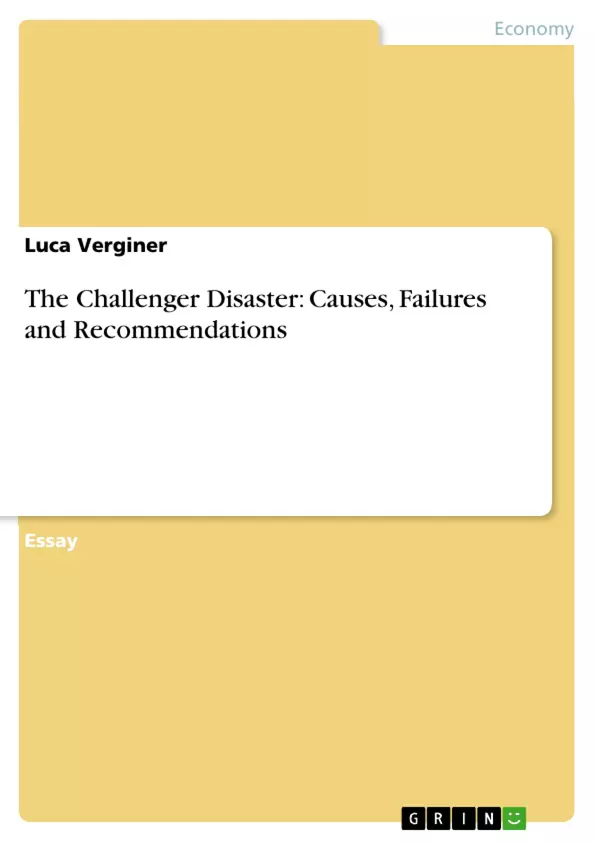This report looks into the causes leading to the challenger disaster from different perspectives and
in the final part possible solutions are explored which could have prevented the disaster. The disaster
has been found to be the consequence of inefficient communication and public pressure.
Table of Contents
1 Introduction
2 Chronology of events
2.1 Pre-Launch
2.2 Launch day
3 The Root Causes
3.1 Technical
3.2 Human
3.3 Organisational
4 Recommendations
5 Conclusion
6 References
1 Introduction
This report looks into the causes leading to the challenger disaster from different perspectives and in the final part possible solutions are explored which could have prevented the disaster. The disaster has been found to be the consequence of inefficient communication and public pressure.
illustration not visible in this excerpt
Figure 1-1: Shuttle launch phases, no problems (source: own design)
2 Chronology of events
2.1 Pre-Launch
In January 1985, Roger Boisjoly, an engineer at Thiokol, a NASA-contractor for the Solid Rocket Boosters (SRBs)1, identifies a critical failure on mission 51C’s O-rings (Everett and Burke-Ward, 2006). This component ensures that the combustion engine and the solid fuel tank segments are hermetically sealed-off from the nearby hydrogen tank (Martz and Zimmer, 1992). Boisjoly analyses the failure and concludes that the exceptional cold launch conditions were the cause for the malfunction (Day, 2000 , Vaughan, 1996).
The problem is brought to the attention of Thiokol’s management. The risk is deemed together with NASA to be acceptable (Day, 2000).
August 1985, a taskforce at Thiokol is set up to investigate the defect and concludes that the O- Rings becomes brittle at low temperatures (Everett and Burke-Ward, 2006).
2.2 Launch day
Mission 51L, has been moved 4 times prior to Tuesday, January 28, 1986. Weather forecast predicts the temperature to drop to -7 degrees Celsius. Thiokol and NASA set up a meeting to discuss the O-Ring-memo. Thiokol’s presentation was rushed but the recommendation clear: “no launch”. NASA was under pressure to be on schedule, since 12 more flights were planned for the year (Everett and Burke-Ward, 2006). Thiokol’s management team then ignored the recommendation and agreed that the data was inconclusive.
illustration not visible in this excerpt
Figure 2-1: Challenger Launch chain of events leading to explosion (source: own design)
11:38:00.010 EST, the Shuttle lifts off (see Figure 1-1 (1 and 2)). 73 seconds later hot gas leaks from the SRB-sealing, pierces the fuel tank (3), ignites the pressurized hydrogen tank and causes it to explode and destroy the Challenger (4).
3 The Root Causes
3.1 Technical
The disaster had one major design flow at its core, namely the temperature sensitive SRB O-ring sealing. Two O-rings sealed the SRBs and this component was therefore classified as critical but redundant . The main implication was that the priority to fix this problem was lower than for critical and unique parts (Gouran et al., 1986).
illustration not visible in this excerpt
Figure 3-1: Joints of Solid Rocket Booster segment and O-Ring sealing (source: Blumberg (2011))
Since both sealings would perform equally unpredictable at low temperatures, it should have been classified as unique. The low temperature on launch day was the catalyst for the incident, it was not the cause but it rendered the flawed O-ring design fatal (Romzek and Dubnick, 1987).
3.2 Human
The causes leading to the incident were in part human error and misjudgement. However no instance of protocol breach, is to be found (Gouran et al., 1986).
A lack of efficient and timely communication is responsible for the “go” decision. Misjudgement and flawed priorities are the cause for the lack of action. Thiokol’s management misjudged the O-ring problem when it was brought to its attention, and did not explain the implications to NASA, due to inefficient communication. No meaningful measures to fix the problem were taken, possibly due to NASA’s assessment that the risk was acceptable and unilateral action by Thiokol would have been against NASA’s wishes. NASA conversely did not look for solutions following the memo (Gouran et al., 1986).
[...]
Frequently asked questions
What is the subject of the document?
The document is a report analyzing the causes of the Challenger disaster.
What are the main sections covered in the document?
The document covers an introduction, a chronology of events (pre-launch and launch day), root causes (technical, human, and organizational), recommendations, a conclusion, and references.
What were the key events leading up to the Challenger disaster?
The document highlights Roger Boisjoly's discovery of O-ring failure in January 1985 due to cold launch conditions, Thiokol's management deeming the risk acceptable, a taskforce concluding O-rings become brittle at low temperatures, and the eventual launch on a day with extremely low temperatures despite recommendations against it.
What was the role of the O-rings in the disaster?
The O-rings, designed to seal the Solid Rocket Boosters (SRBs), failed due to low temperatures, leading to hot gas leaks, piercing of the fuel tank, and the subsequent explosion.
What were the technical causes of the Challenger disaster?
The temperature-sensitive SRB O-ring sealing was identified as a major design flaw.
What were the human factors contributing to the disaster?
Inefficient communication, misjudgment, and flawed priorities, particularly regarding the O-ring problem, are identified as human factors.
What were the conclusions of the report?
The disaster was a consequence of inefficient communication and public pressure.
What is the significance of Roger Boisjoly's role?
Roger Boisjoly, an engineer at Thiokol, identified a critical failure on mission 51C’s O-rings and recognized the link between cold temperatures and O-ring malfunction.
What was NASA's role in the decision to launch?
NASA was under pressure to maintain its launch schedule, which potentially influenced the decision-making process despite concerns raised about the O-rings.
What does the report suggest about the classification of the O-ring sealing?
The report suggests that because both sealings would perform unpredictably at low temperatures, it should have been classified as unique rather than critical but redundant.
- Arbeit zitieren
- Luca Verginer (Autor:in), 2012, The Challenger Disaster: Causes, Failures and Recommendations, München, GRIN Verlag, https://www.grin.com/document/208006



